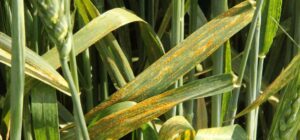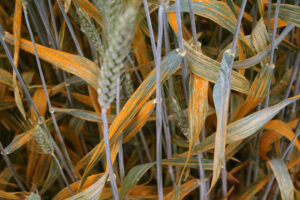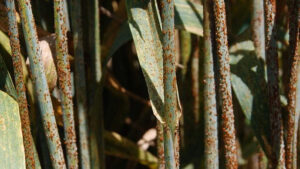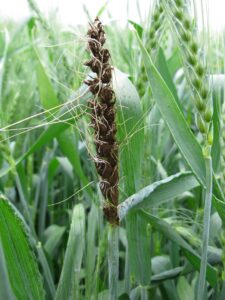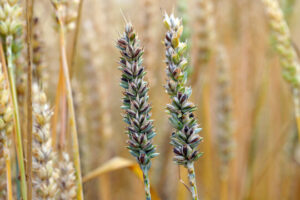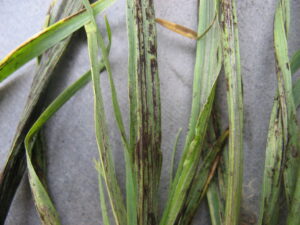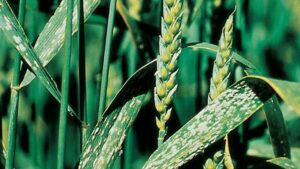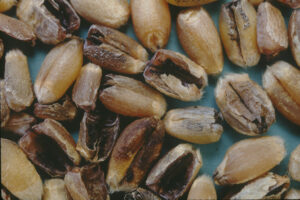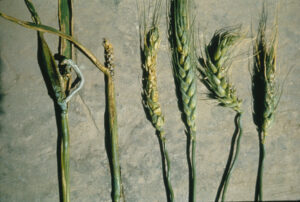Disease Control
Attacks/ Symptoms |
Control |
|
Yellow Rust/ Stripe Rust: It starts from the appearance of Yellow colour stripes produced parallel along the venation of each leaf blade. When the disease is more severe the yellow colour spores are produced when touching the plants. Leaves with hands. Stripes start turning black with the increase in temperature.
|
1. Grow disease resistant varieties like H.P.W.- 360, 368, 349, H.S.-562, H.S.-542 etc. After 2-3 years, replace them with new approved disease resistant varieties. 2. As soon as the first symptoms of disease appear in the crop, spray Prapiconazole 25 EC. (0.1%) or Mancozeb 75 W.P. (0.2%) at an interval of 15 days. |
| Brown Rust: Circular and brown scattered pustules appear on the leaves.
|
Same as above |
| Black Rust: Dark reddish brown colored pustules occurs on both sided of leaves, stem and on the spikes. Later on the spore masses break through the surface tissue.
|
Same as above & Grow recommended crop varieties. |
| Loose Smut: The entire inflorescence is commonly affected and appears as a mass of olive black spores, initially covered by a thin grey membrane. Once the membrane ruptures, the head appears powdery.
|
1. Grow disease resistant varieties. 2. Soak the seed for 6 hours in Propiconazole 25 E.C. solution and then go for sowing after drying the seed in shade or treat the seeds with Carbendazim (2.5 g/kg seed) or Rexil (1 g/kg seed). 3. As soon as the symptoms of the disease appear, remove the diseased plants and burn them or bury them outside the field. Note: Treat seeds at the time of sowing. |
| Hill Bunt/ Stinking Smut: When the grains in the affected ears are fully ripe, they get filled with sticky spores and give off a strong smell like rotten fish, but they have no effect on the grain shells.
|
Treat the seeds with Carbendazim (2.5 g/kg seed). |
| Flag Smut: Long black stripes are formed on the leaves parallel to the veins. These stripes later produces black powdery (spore group) substance when burst. The disease leads to twisting and dropping of leaves followed by withering.
|
1. Treat the seeds with Carbendazim (2.5 g/kg seed). 2. Do not delay sowing. 3. Irrigate the field immediately after sowing where the disease is prevalent. 4. Remove diseased plants and burn them. |
| Powdery Mildew: On affected plants, a light layer of white to greyish cotton of fungus is visible on the leaves, stem and floral parts.
|
Spray Carbendazim (0.05%) on the crop at an interval of 15 days |
| Karnal Bunt: This disease occurs on some grains of an ear of an affected plant. Diseased grains partially turn into black powder.
|
1. Grow recommended varieties. 2. Treat the seeds with Carbendazim (2.5 g/kg seed). 3. First spray of Propiconazole 25 E.C. (0.1%) on flag leaf stage of crop is recommended and second spray when 50% of the ear buds emerge from the plants (10-12 days after the first spray). Spray Propiconazole only for seed crops. Note: It has been observed that fungicide chemicals do not have residual toxicity as compared to pesticide chemicals. If the crop fails for seed, that may be consumed by the farmer as food. |
| Ear Cockle and Yellow Rot: Diseased earheads are twisted and do not fill with grains. And there is yellow sticky substance on them. Later, balloons filled with dark coloured spores remain attached to the earheads.
|
1. Remove and destroy diseased plants. 2. Put the seeds in 5% salt solution and remove the floating seeds and destroy them. |




